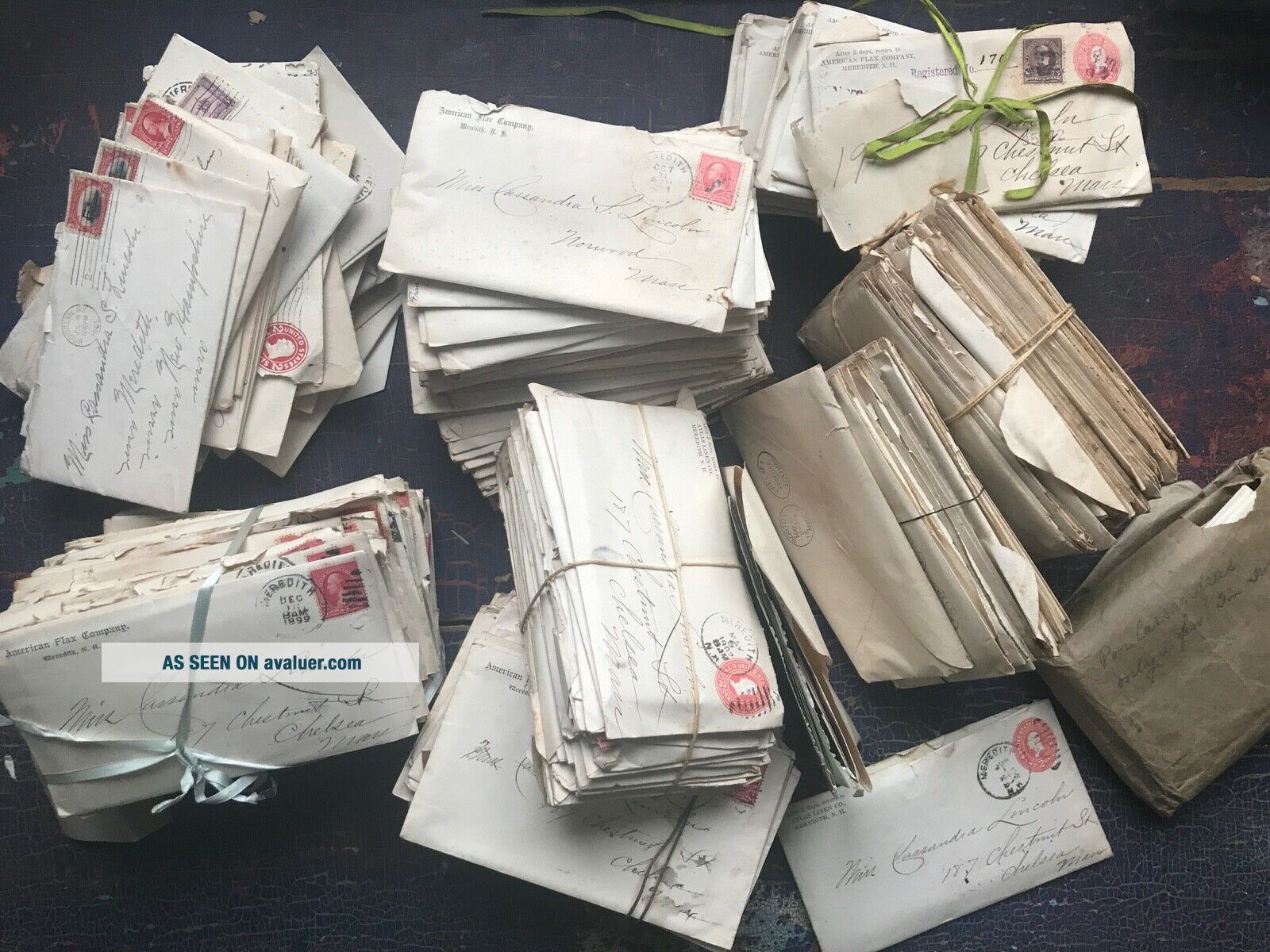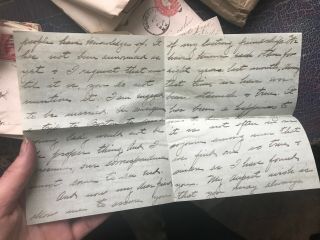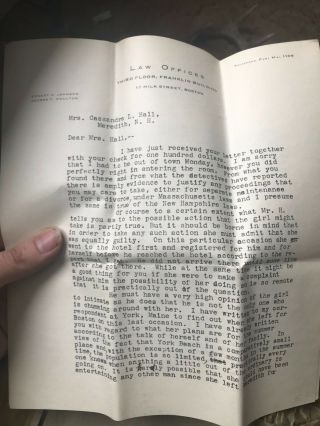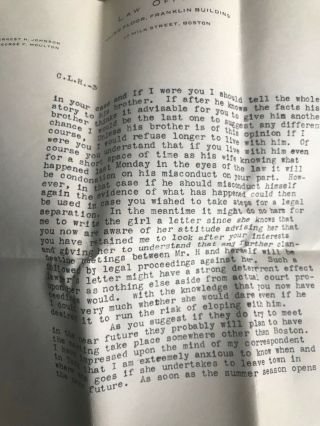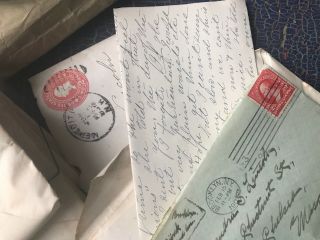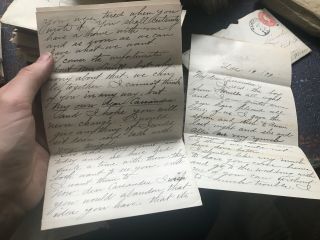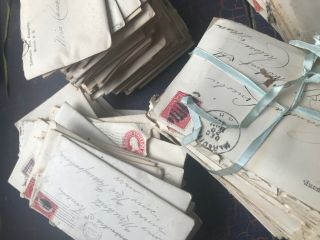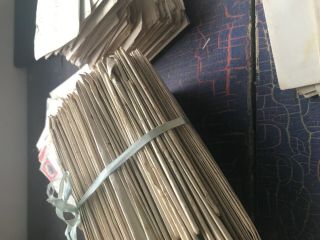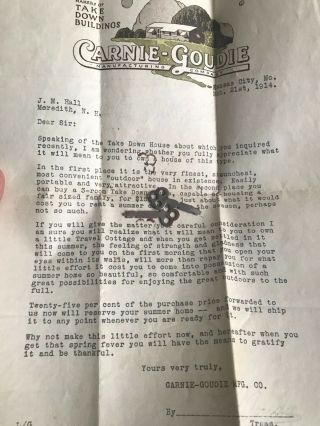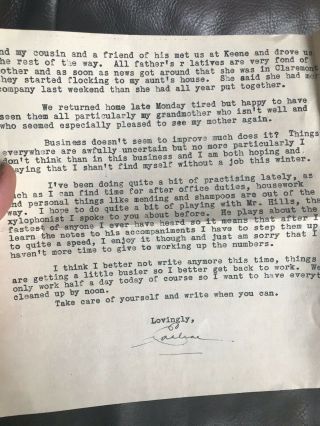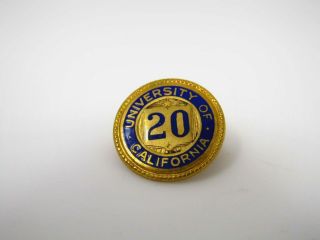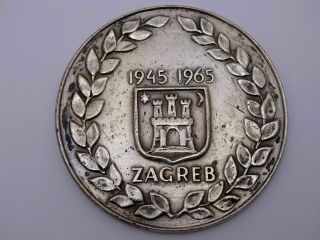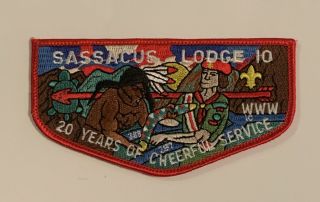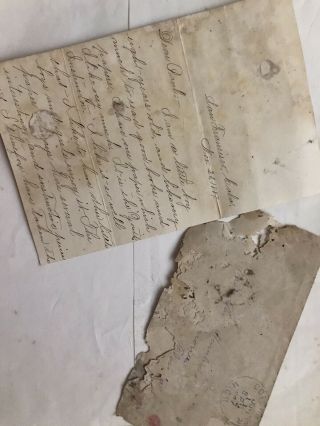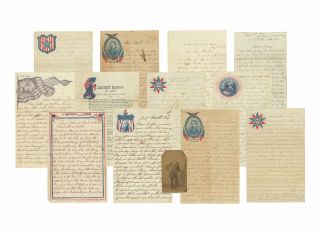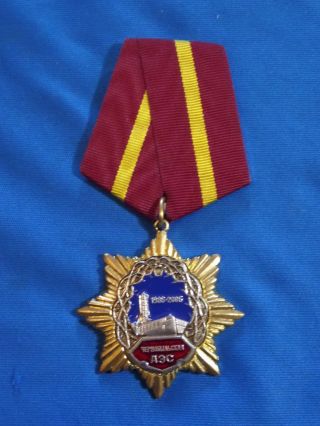20 Year Archive Of Historical England Handwritten Letters Manuscript 1800s
Item History & Price
| Reference Number: Avaluer:1293 | Handmade: Yes |
| Country/Region of Manufacture: United States |
A once in a lifetime auction. Spanning from the 1880’s to the mid-1900s, This is a very rare collection of personal letters that stand as a record of a life and an affair, from some of oldest families in New England. The Swasey/Lincoln’s (see below). Much of the Lake Winnipesaukee Area is named after them and I’ve included some excerpts of Lakes region history in which the people in the letters are mentioned. What is not mentioned in the history of Meredith, NH is the tumultu...ous relationships and romances featured in these letters. There is the beginning of Cassandra and John Minot’s romance ( it is unclear if one or both of them is involved with someone else in the beginning) and then a parcel of letters from much later in 1914 containing lawyers letters and documentation of a private detective who follows Mr. Hall and another woman (Miss Gibson) at the request of Cassandra, as she suspects Minot has been lying to her about an affair. There is even a letter from a cottage rental place he was trying secure, complete with the keys tucked inside. This is with the lawyer letters as evidence. There is much more that I haven’t personally dug into yet, family advice, sisters, and a greater catalog of letters from family and friends. More pictures upon request.
The Letters are mainly centered around the people Listed below.
Cassandra Swasey Lincoln /Hall 1876-1916 (she passed two years after the affair at age 40)
John Minot Hall
Col Ebenezer Stevens 1810-1901
Ebenezer Stevens Lincoln 1879-1964
Mary Alice Lincoln Hale 1882-1968
Honorable Mentions:Agnes Statham of Winthrop MAJohn Prescott Boston Rubber Shoe Company, Malden, MA (1901)Ball Bros. Glad Manufacturing CompanyYoung’s HotelsProspect HouseMany places around NH and MAAnd much and many more.
GENEALOGICAL AND HISTORICAL INFORMATION:
What Became of John Bond Swasey and his Land? Approximately twelve years after the completion of the Waukewan Canal, John and Alice Swasey began to construct a new home on the west side of Main Street behind their current house. Unfortunately, John died of appendicitis on March 11, 1828 and did not get to see the completion of his new home. The well-preserved early Greek Revival house with distinctive two- story porch was completed after his death by Alice and remains in his family to this day. John Bond Swasey is buried at the Swasey Cemetery on Lang Street. Upon her husband’s death, the Swasey homestead and accompanying parcel were inherited by Alice Ladd Swasey. It was under Alice’s supervision that the well-preserved early Greek Revival home was completed. Alice also ran the mills after the death of her husband, which was something very unusual for the time. March 9, 1867, Alice Swasey sold the extensive prop- erty for $750 to her son-in-law Col. Ebenezer Stevens. At this time, the property contained about twelve acres and was bounded by the northeast corner of Joseph W. Lang’s lot, then westerly parallel to the street from John Mudget’s House to the RR. Depot, to Daniel Hilton’s land, southwest to the outlet of Waukewan, northeasterly to lands of William J. Elliott, Da- vid Vittum and Charles S. Prescott. Ebenezer Stevens (1810-1901) was born in Gilford to Paul and Sally Howe Stevens and married Cassandra Swasey on April 22, 1846. Prior to his marrying Casandra, he had worked as a blacksmith out of a shop in Gilford village. He moved, with his first wife and small children, to Meredith village in 1837 and continued to work as a blacksmith until his wife’s early death in 1845 at the age of 33. In 1845 he was elected selectman and served for three years. He was also a Justice of the Peace, and a representative in 1854 and 1855. “He was one of the incorporators and served as president and treasurer of the Meredith Mechanic Association, one of the incorporators and trustee of Meredith Village Savings Bank, one of the directors of the Belknap County Bank, Laconia, and also a trustee of Laconia Savings Bank.” Ebenezer and Cassandra Stevens lived in the Swasey Homestead on Main Street with their daughter Alice Swasey Stevens (1849-1937). When Co. Ebenezer Stevens died on February 15, 1901, he left his estate to his grandson, Ebenezer Stevens Lincoln. Ebenezer S. Lincoln died in 1964. On November 7, 1965, his land was inherited by his sisters, Celestina Hope Lincoln and Mary Alice (Lincoln) Hale. When she died on March 13, 1968, Mary Alice (Lincoln) Hale’s half of the estate was inherited by her daughters Alzora Elizabeth (Hale) Eldridge (1916-1979) and Alice (Hale) Andrew (1912-1996). September 5, 1974, a portion of the Swasey property was given to the Town of Meredith for use as a recreational park by Hope Lincoln, Alzora H. Eldridge, and Alice H. Andrew. The Swasey Park was officially dedicated on July 5, 1976.
Swasey Park Swasey Park is significant to the history of Meredith for its relationship with John Bond Swasey (1781-1828), his Waukewan Canal, and the resultant development of Meredith into a bustling mill town. Early History of Meredith and the Swasey Family: Early records speak of a Native American presence at the outlet of Lake Waukewan. Though there is no known archaeo- logical evidence in Swasey Park, it is very likely that Native Americans lived along the shore of the cove during the sum- mer months. Abenaki Native American settlements are documented in Meredith Village and at the nearby Weirs, Stonedam Island, Center Harbor, and Holderness Village. The cove that became Swasey Park would have been rich in food resources, had a reliable source of water, and have been convenient for transportation and trade between the many sur- rounding lakes. Though the Abenaki withdrew to the north around 1675-76, early reports of Meredith mention an aban- doned wigwam “near the outlet of Lake Waukawan.” Meredith was granted December 31, 1748. At this time, it was known as Palmerstown, after Samuel Palmer, a grantee from Hampton, NH. Meredith was incorporated December 21, 1768 as the Town of New Salem. In 1855, Laconia (“Meredith Bridge” split off, and in 1873 a section of the Town of Meredith was given to Center Harbor. One of the earliest European residents of Meredith was Benjamin Swasey (1754-1783), who arrived in Town at the time of the Revolutionary War. Benjamin Swasey was born in Old Newbury, MA on May 5, 1754 and married Jane Bond (1759 -1840) in Exeter, NH on February 15, 1777. On May 19, 1777, when Benjamin was 23, his father purchased 95 acres in Meredith for him on what was later called Cass Hill. He built a house at the top of Old Center Harbor Road, near the cor- ner of Gilman Hill Road and brought his bride to settle in Meredith. The couple had four children: Jane Swasey (1779- 1842), Sally Swasey (1780-1870), John Bond Swasey (1781-1828) and Benjamin Swasey (1784-1863). Many members of this first generation are buried at the family plot near the corner of Old Center Harbor and Gilman Hill Roads, by the foun- dations of the Prospect House. John Bond Swasey (1781-1828) John Bond Swasey was born April 3, 1781 in Meredith and married Alice Ladd (1779-1875) July 14, 1809. Shortly after his marriage, John began to buy up all of the land along the Measly Pond Brook (which ran from Lake Waukewan through the lumberyard, past the present fire department, and emptied into Winnipesaukee near the town docks) and all of the water rights (“mill privileges”). In 1809 he bought land on the south side of the brook from Daniel Avery. In 1811, he purchased more land along the book, including grist and fulling mills with mill equipment. With Avery, he bought the saw mill and mill yard from a group of six share-holders. In 1813, he bought two more properties. In 1816, he bought the last remaining piece of land between long cove and the village of Meredith from Daniel Avery. John Bond Swasey also established a store in general merchandise, across from his house on Main Street. John Bond and Swasey Park Design Charrette . June 2016 ty by the Meredith Electric Light Company. The new working force for the mills led to a need for housing, public buildings, churches, banks, and hotels, creating the Meredith Village landscape that we see today. Meredith remained an industrial town until after World War II, when Route 3 was realigned. As visitors flocked to the Lakes Region with their newfound automotive freedom, the economy of the town shifted to one based in tourism. The last of the mills closed in 1982, and is now the shopping center and hotel at Mill’s Falls.
Col Ebenezer Stevens:
Revolutionary Soldier
Grandfather was Maj Ebenezer Stevens (Died 12/5/1710) whom married Elizabeth Colcord and had 4 sons.
Son of Paul and Sally (Howe) Stevens, was born May 9, 1810, and when he was 7 yrs old, was compelled to begin the battle of life. He first went to live with a farmer whose home was back of the Belknap Mountains, in what was called "The Cellar." In a year he changed his abode, but until he was fourteen his occupation was "tilling the soil." He then learned blacksmithing of his brother William, and worked for him for some time.Earning some money, he attended school and boarded with Dr. Crosby and wife. Before he was seventeen, he purchased an old shop in Gilford village, on credit, establishing himself as a blacksmith, and his business thrived. Mr. Stevens married, January 15, 1831, Therina, daughter of John S. and Leah (Prescott) Osgood, and granddaughter of Colonel Prescott of Gilmanton. They had three children--Cyrus A., Celestia A.(married Edward Stowell, resides in North Adams, and has two children), and Ebenezer (who died when four years of age). Mrs. Stevens died January 17, 1845, aged thirty-three years.
In 1837 Mr. Stevens removed to Meredith village and carried on blacksmithing until 1845 doing a large business. About 1850 he engaged in merchandising with Joseph W. Lang in partnership for six years.
He married April 22, 1846 Cassandra, daughter of John B. and Alice (Ladd) Swasey of Meredith, and had one child--Alice S (married Henry W. Lincoln, of Norton, Mass; they have three children).[Mrs. Swasey is a descendant of two early New Hampshire families of repute, her father being third in descent from Ebenezer Swasey ofExeter, whose son Benjamin, born at Exeter October 16, 1752, married Jane Bond, February 15, 1777, and moved to Meredith, where John B. was born April 3, 1782. He settled in Meredith village, became a prominent business man, having a large mercantile trade; he erected large mills on the water privilege there and served the town as postmaster. He died March 11, 1828. His wife, Alice Ladd was a descendant in the sixth degree from Daniel Ladd (see biograph of Seneca Ladd), the line being Daniel (1), Samuel(2), John (3), Timothy (4), Eliphalet (5) (born February 19, 1775 married Mary Park of Windham May 13, 1778), Alice (6), Mrs. Alice (Ladd) Swasey died February 6, 1875, aged ninety-six years.
From about the age of seventeen Mr. Stevens took an interest in militia matters, and was rapidly promoted through the various grades to that of colonel, and held the offices of brigade and division inspector for many years. In 1845 he was elected selectman andserved three years, and conducted several important lawsuits for the town to a succesfull issue. He held the commission of justice of the peace for over forty years. He was a representative in 1854 and 1855. An old Whig, he became an active Republican, and wasPresidential elector for Lincoln in 1860. He was selectman of Meredith during the Rebellion. He was connected with the Free-Will Baptist Church since 1840; has been trustee of the New Hampton Seminary. He was one of the incorporators and served as president and treasurer of the Meredith Mechanic Association; one of the incorporators and trustees of the Meredith Village Savings-Bank;one of the directors of the Belknap County Bank, Laconia, and also a trustee of Laconia Savings-Bank.
A Brief History of Meredith, NHWhat is now the lovely village of Meredith, New Hampshire was once the site of fledgling industries and commercial enterprises that led to Meredith's development.In the late 1700's Atlantic Salmon and Shad still swam up the Merrimack and Winnipesaukee River Basins to a series of small waterfalls connecting Lake Winnipesaukee with Lake Waukewan located in the hills above Meredith. The waterway between the two lakes was a natural source of waterpower for the early mills founded at the beginning of the Industrial Revolution in this country.In 1795, John Jenness bought the water rights and land along this outlet which is now tiny Corliss Brook running between Lang Street and Stevens Avenue and past the fire station before trickling into Meredith Bay near the Town Docks.Jenness built a grist mill and a saw mill on the waterway. Besides the mills, Meredith then consisted of only 10 dwellings and a general store. The property soon changes hands. At the turn of the century a young man named John Bond Swasey purchased or inherited most of the land on which Meredith Village now sits.Swasey had inherited a 95 acre lot from his father Benjamin who had bought the land in 1777. The farm was located in what is now the core of Meredith Village.Across from his homestead on Main Street, (which is now the home of Paul and Kristen Eldridge and the offices of Compass Rose Buyer Brokers and Eldridge Appraisals) Swasey owned the general store which supplied the many new settlers moving into Meredith Village. According to remembrances of early 19th century residences, however, the mills ceased operation sometime between 1810 and 1816.Swasey then undertook a project that was to have great significance for the town of Meredith, a project that marked the beginning of the development of the present Mill Falls Marketplace site.Starting from the frontage on Lake Waukewan that is now called John Bond Swasey Park, Swasey built a rock-lined canal over 600 feet in length channeling the water under the Main Street horse path to where the land drops sharply to Lake Winnipesaukee.Water power was now concentrated into one fall of about 40 feet. The Waukewan Canal and the falls were probably completed by 1818.Now Swasey was able to build a number of profitable mills for sawing lumber, grinding flour, combing cotton flax and weaving cloth. All these mills helped stock the shelves of the Swasey store. Swasey's man made waterfall was considered among the best mill drivers in the state.Swasey died in 1828 at the age of 46. He had carved out an industrial center that became the hub of Meredith. Town citizens today still credit him with nursing the village through its infancy, and setting the town on the road to prosperity.The current restored mill at Mill Falls may have been producing textiles at its beginning. Some historical evidence indicated the large mill was built and housed a rustic cloth manufacturing business by about 1820. However, according to the "History of Belknap County, " written in 1885, the mill was a grist mill until Joseph W. Lang and several partners founded the Meredith Village Cotton Factory Company at the site in the 1830's, after purchasing it from the Swasey estate.The cotton mill evidently did not prosper for very long. The same history book says the mill was "an idle cotton mill by 1850." Soon after a man named Seneca Ladd leased the mill and installed new machinery "for theManufacture of pianos and melodians."In 1858 a man named Joseph Ela recognized a new cooperative effort was necessary to promote growth in the town. Swasey's waterfall and the canal were key to the town's further development. So Ela and his partners formed a corporation, The Meredith Mechanics Association, to buy and control the water rights and mill buildings along the waterway. Ela was the first president of what was locally called "The Corporation."The purpose of The Meredith Mechanics Association was to make capital investments to attract new manufacturers to the town, and utilize available mill space. The corporation constructed a flume or chute for the waterfall and made numerous other improvements to the water power system. In time, most of the land encompassed by Main Street, Dover Street and Lake Winnipesaukee was purchased by The Meredith Mechanics Association.In 1889, a disastrous fire destroyed one of the larger mills owned by the Mechanics Association. The disaster triggered the beginning of the end for the Association. The tenant of the mill that was destroyed was Hodgson Hosiery, perhaps the town's most profitable company at the time, and a major source of income for the Association. The firm had employed 160 workers before being put out of business by the fire.Then in 1890 the founder of the Association, Joseph Ela, died at the age of 93. In that same year, Sam Hodgson bought the property of the association and formed the Meredith Water power Company.The current mill of the Mill Falls Marketplace was one of many buildings on the site at the turn of the century. The rights to these mills were purchase from Hodgson about this time by J. Q. A. Whittermore, an investor from Newton, Mass. He empowered two brothers, Allie and Minot Hall to develop linen manufacturing operations at the site.The Halls were very successful. Each year the factory turned out increasing quantities of linen towels, and the workforce increased accordingly. The Halls soon married into some of Meredith's oldest families. Minot Hall married Cassandra Swasey Lincoln, Great-Granddaughter of John Bond Swasey.Bringing use back to the present - Paul Stevens Eldridge, Owner of Compass Rose Buyer Brokers, is the Great-Great-Great-Grandson of John Bond Swasey. We hope you have enjoyed this brief history of early Meredith.
Swasey/Swayze
Table of Contents from Genealogy of the Swasey Family
FIRST GENERATION. John Swasey and his two sons Joseph and John, Jr., emigrate to America and settle in Salem, Mass. Tradition that they came from Wales. Being of the Quaker or Friends faith the father and son John emigrate to Southold on Long Island, state of N. Y. Indian deed to the Town of Brookhaven on L. I. Chart — showing the separation of the two brothers Pages 19-26 SECOND GENERATION. Salem, Mass., Branch. Joseph Swasey remains permanently at Salem. He divides his property among his children . . . Pages 27-3 1 Southold Branch. Abagail, one of the daughters of John Swayze, marries John Hallock of Southold, who is disinherited by his father, William Hallock, because he married into the society of Friends or Quakers. Will of John Swayze Pages 33-38
THIRD GENERATION. Salem Branch. Joseph Swasey left the Old Homestead on English St. in Salem and moved to Beckford St., where all his children are born Pages 39-41 Southold Branch. Joseph Swezey marries Mary, the daughter of Richard and Mary Betts of Newtowne, L. I Page 42
FOURTH GENERATION. Salem Branch. Samuel Swasey purchased the Lambert estate in Salem. His will. Joseph Swasey settles in Old Newbury, Mass. He was one of the Founders of the third parish. His dwelling house now standing. Chart — Pedigree of Joseph Swasey Pages 43-50 Southold Branch. Judge Samuel Swayze moves from Southold to Rox- bury, N. J. His will, Chart — Pedigree of Judge Samuel Swayze. Stephen Swezey the Founder of Swezeytown in Brookhaven, L. I Pages 51-66
FIFTH GENERATION. Salem Branch. The Swasey Tavern or Inn, where Gen'l Washington was entertained on his journey through New Eng land, 1789. Joseph Swasey's house, Somerset, Mass. Opposite p. 68. House of Samuel Swasey of Old Newbury. Op posite p. 44. He conveys the Haseltine estate in Haverhill, Mass., to his son Moses. Joseph Swasey moves from O. N. to Exeter, N. H., 1735. Capt. Ebenezer Swasey moves from O. N. to Exeter, N. H., 1763. His will and Inventory. His sec ond wife one of the Founders of the Bapt. Church in Exeter in 1 805 Pages 67-90
Southold Branch. Rev. Samuel Swayze, First Cong, minister of Roxbury, N. J. He and his brother, Richard, both Loyalists, with their families, emigrate to Western Florida (now Mississippi), where they purchase 19, 000 acres of land. The Little Book. Inscriptions upon tombstones in the Swayze cemetery at Hope, N. J.
Barnabas and Israel Swayze share in 800 acres of land in Hope, N. J., given them by their father. Will of Barnabas Swayze. Will of Israel Swayze. Caleb Swayze, a Loyalist, moves to Canada before the Rev. War and espouses the cause of King George III Pages 91-128
SIXTH GENERATION. Salem Branch. Samuel Swasey, of Marblehead, Major Joseph Swasey at the Battle of Bunker Hill. Moses Swasey's wife, Mehitable Page, granddaughter of Gen'l Thomas Dustin and Hannah Emerson Dustin of Haverhill, Mass., captured by the Indians, 1692. The Swaseys of Bucksport, Me. Chart — Descend ants of Edward Swasey of Exeter, N. H. Chart — Descendants of Benjamin Swasey of Meredith, N. H. John Swasey of Salem, Mass., Naval Officer under Nathaniel Hawthorne, Collector of the Port of Salem Pages 129-173
Southold Branch. The Swayzes of Canada, Israel Swayze, a Loyalist, and his wife, Abagail Coleman, emigrate to Canada, near the close of the Rev. War. Their descend ants, Col. Isaac Swayze, a son of Caleb, in Canada, a terror to the Whig or patriotic party. Daniel Swezey and his family emigrate to the wilds of N. Y. State. His descendants. Joshua Swezey mar ries Hannah Benjamin Pages 175-270
Seventh Generation. Salem Branch. Swasey families of Newbury, Vt. ; North Haverhill, N. H. ; North Danville, Vt. ; Farmington, Van Buren County, la.; Claremont, N. H.; Limerick, Me. Nathaniel Swasey, Exeter, N. H. ; Henry Somersby Swasey, Newburyport, Mass. John Swasey, of Cincinnati, Ohio Pages 271-381
EIGHTH GENERATION. Salem Branch. Hon. John Philips Swasey of Canton, Me. Dr. Oscar Fitzwilliam Swasey of Beverly, Mass. Lydia Ann Swasey O'Bear of New Ipswich, N. H. Ben jamin Swasey, a native of Laconia, N. H., one of the '49ers. Eben Swasey of Portland, Me. Am brose Swasey of Exeter, N. H., now of the firm of Warner and Swasey, Cleveland, Ohio, builders of the Lick and the Yerkes telescopes, the largest ever constructed Pages 403-467
Southold Branch. Judge Francis Joseph Swayze of Newark, N. J. Capt. Jason Clark Swayze of Hope, N. J., assassinated at Topeka, Kans., 1877. Dr. George Banghart Henry Swayze, founder of the Medico-Chirurgical College, of Philadelphia, Pa., author of "Yarb and Cretine; or, Rising from Bonds, " a novel of the Race Problem on the Reconstruction of the South Pages 469-476
NINTH GENERATION. Salem Branch. The family of Darius Ladd Swasey. The family of Frank Marshall Swasey Pages 477-478



